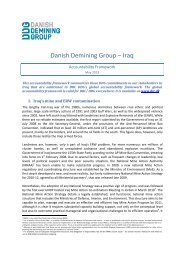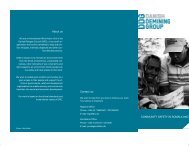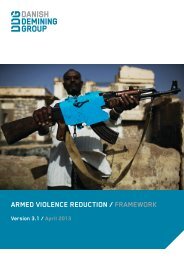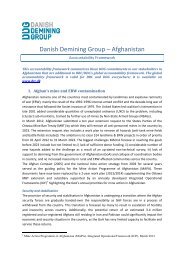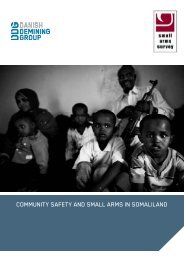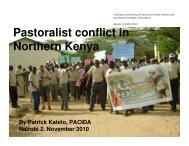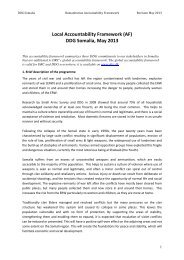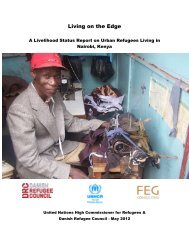Read the full report - Danish Refugee Council
Read the full report - Danish Refugee Council
Read the full report - Danish Refugee Council
You also want an ePaper? Increase the reach of your titles
YUMPU automatically turns print PDFs into web optimized ePapers that Google loves.
52 DRC / DANISH REFUGEE COUNCILWFP’s food-for-voucher programme in Kabul:The use of vouchers has been implemented by WFP in 2012 through a programme covering 19 000disabled and widows on all police departments of Kabul. Vouchers of 1250 afghanis were distributedon a monthly basis to beneficiaries in four distribution sites, over a period of six months, and could beredeemed in 66 shops identified and contracted in <strong>the</strong> neighbourhood of <strong>the</strong> areas of residence ofbeneficiaries. The choice of implementation of vouchers was perceived as more adequate in Kabuldue to <strong>the</strong> accessibility and size of <strong>the</strong> market, and <strong>the</strong> availability of banking networks. An agreementwas concluded with four branches of Kabul bank to open special encashment centres for traders tocash <strong>the</strong> amount of <strong>the</strong> voucher.“Security, for instance is not an issue with vouchers. We may face more challenges in terms ofsecurity with in-kind. Our trucks were attacked and food looted. Vouchers: nobody can misuse <strong>the</strong>m.Each beneficiary has a ration card. At <strong>the</strong> start of <strong>the</strong> project, we distribute ration cards. They take itwith <strong>the</strong> voucher to <strong>the</strong> shop to make sure <strong>the</strong> person was <strong>the</strong> right one. The card is punched. But weneed to make sure <strong>the</strong> shopkeepers are not cheating <strong>the</strong>m, because <strong>the</strong>y are illiterate, charge <strong>the</strong>mmore or do not give <strong>the</strong>m <strong>the</strong> right amount of food for <strong>the</strong> value of <strong>the</strong>ir voucher. We had monitors on<strong>the</strong> sites. In Soudan, <strong>the</strong>re was a lot of overcharging. Beneficiaries didn’t understand <strong>the</strong> entitlements:<strong>the</strong> shopkeepers would give less food or poor quality. We had established a committee withrepresentatives of beneficiaries, traders and our partners. We met on a regular basis and discussedsuch issues. If beneficiaries complain, we do assessments and WFP had <strong>the</strong> right to terminate <strong>the</strong>contract. We had a specific contract for each trader” – WFP Area Manager, Kabul.Mobile cash transfers: Innovative practices such as mobile transfers could present analternative option to Hawala. Findings form <strong>the</strong> quantitative survey fur<strong>the</strong>r showed 61% ofhouseholds have at least one mobile, 13% have two, and 2% 3 or more. However, 24% ofrespondents mentioned no member of <strong>the</strong>ir households owned a mobile phone, and 91%<strong>report</strong>ed no women in <strong>the</strong> household possessed one. In <strong>the</strong> perspective of targetingwomen, distribution of mobile phones might need to be considered. The highest obstacleto <strong>the</strong> transfer of cash through M-PAISA in KIS would be <strong>the</strong> lack of documentation papers,a key requirement for receiving cash at M- PAISA centres. A first step would be to develop acustomized system with Roshan, who has been <strong>the</strong> main provider of M-PAISA (Afghanversion of M-PESA) since 2008, or alternatively with Etisalat (with M’HAWALA). Exploringcommunity networks of solidarity and assessing <strong>the</strong> degree of trust between members ofhouseholds and community members owning documentation papers could be an option.Direct Distribution: Given <strong>the</strong> accessibility of <strong>the</strong> KIS, handing out money directly throughNGO staff or implementing partner might be considered as a viable option. Along with <strong>the</strong>use of Hawala system, direct cash transfer is <strong>the</strong> current preferred way of transferringmoney employed by NGOs implementing cash transfers in Afghanistan. However, insituation of increasing instability, cash transfers have been identified as a secure way ofproviding assistance. As underlined in <strong>the</strong> next section, mitigating risks of cash distributioncan ensure higher levels of security for staff than in-kind transfers, due to <strong>the</strong> low visibilityof cash as compared to in-kind.The volatile security concern in Afghanistan raises high concern about <strong>the</strong> risks associated withdistribution of cash. Though in many ways, in-kind distribution faces its own risks due to highvisibility, cash remains highly sensitive. Considering both “internal” and “external” factors, asmentioned by <strong>the</strong> above quoted Cash Learning Coordinator, <strong>the</strong> existence of automatic and robustdelivery mechanisms is crucial to preventing risks associated with distribution 44 Practicalrecommendations and current practices mentioned by agencies involved in cash-based approachesin Afghanistan include:44 FARRINGTON J., HARVEY P., SLATER R., (2005), Cash Transfers in <strong>the</strong> Context of Pro-Poor Growth, ODI, London.



